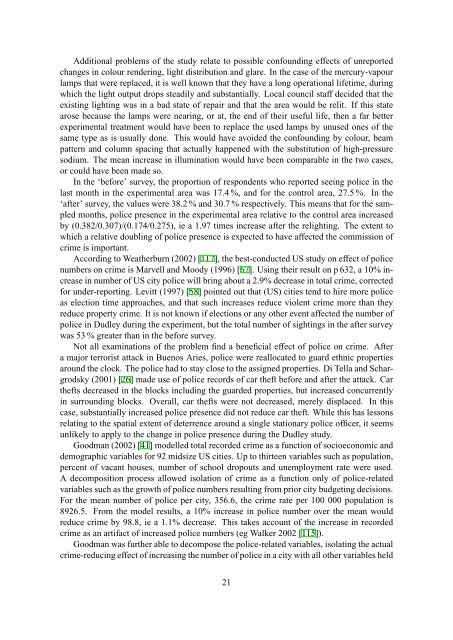outdoor lighting and crime, part 1 - Astronomical Society of Victoria
outdoor lighting and crime, part 1 - Astronomical Society of Victoria
outdoor lighting and crime, part 1 - Astronomical Society of Victoria
Create successful ePaper yourself
Turn your PDF publications into a flip-book with our unique Google optimized e-Paper software.
Additional problems <strong>of</strong> the study relate to possible confounding effects <strong>of</strong> unreported<br />
changes in colour rendering, light distribution <strong>and</strong> glare. In the case <strong>of</strong> the mercury-vapour<br />
lamps that were replaced, it is well known that they have a long operational lifetime, during<br />
which the light output drops steadily <strong>and</strong> substantially. Local council staff decided that the<br />
existing <strong>lighting</strong> was in a bad state <strong>of</strong> repair <strong>and</strong> that the area would be relit. If this state<br />
arose because the lamps were nearing, or at, the end <strong>of</strong> their useful life, then a far better<br />
experimental treatment would have been to replace the used lamps by unused ones <strong>of</strong> the<br />
same type as is usually done. This would have avoided the confounding by colour, beam<br />
pattern <strong>and</strong> column spacing that actually happened with the substitution <strong>of</strong> high-pressure<br />
sodium. The mean increase in illumination would have been comparable in the two cases,<br />
or could have been made so.<br />
In the ‘before’ survey, the proportion <strong>of</strong> respondents who reported seeing police in the<br />
last month in the experimental area was 17.4 %, <strong>and</strong> for the control area, 27.5 %. In the<br />
‘after’ survey, the values were 38.2 % <strong>and</strong> 30.7 % respectively. This means that for the sampled<br />
months, police presence in the experimental area relative to the control area increased<br />
by (0.382/0.307)/(0.174/0.275), ie a 1.97 times increase after the re<strong>lighting</strong>. The extent to<br />
which a relative doubling <strong>of</strong> police presence is expected to have affected the commission <strong>of</strong><br />
<strong>crime</strong> is important.<br />
According to Weatherburn (2002) [117], the best-conducted US study on effect <strong>of</strong> police<br />
numbers on <strong>crime</strong> is Marvell <strong>and</strong> Moody (1996) [67]. Using their result on p 632, a 10% increase<br />
in number <strong>of</strong> US city police will bring about a 2.9% decrease in total <strong>crime</strong>, corrected<br />
for under-reporting. Levitt (1997) [58] pointed out that (US) cities tend to hire more police<br />
as election time approaches, <strong>and</strong> that such increases reduce violent <strong>crime</strong> more than they<br />
reduce property <strong>crime</strong>. It is not known if elections or any other event affected the number <strong>of</strong><br />
police in Dudley during the experiment, but the total number <strong>of</strong> sightings in the after survey<br />
was 53 % greater than in the before survey.<br />
Not all examinations <strong>of</strong> the problem find a beneficial effect <strong>of</strong> police on <strong>crime</strong>. After<br />
a major terrorist attack in Buenos Aries, police were reallocated to guard ethnic properties<br />
around the clock. The police had to stay close to the assigned properties. Di Tella <strong>and</strong> Schargrodsky<br />
(2001) [26] made use <strong>of</strong> police records <strong>of</strong> car theft before <strong>and</strong> after the attack. Car<br />
thefts decreased in the blocks including the guarded properties, but increased concurrently<br />
in surrounding blocks. Overall, car thefts were not decreased, merely displaced. In this<br />
case, substantially increased police presence did not reduce car theft. While this has lessons<br />
relating to the spatial extent <strong>of</strong> deterrence around a single stationary police <strong>of</strong>ficer, it seems<br />
unlikely to apply to the change in police presence during the Dudley study.<br />
Goodman (2002) [41] modelled total recorded <strong>crime</strong> as a function <strong>of</strong> socioeconomic <strong>and</strong><br />
demographic variables for 92 midsize US cities. Up to thirteen variables such as population,<br />
percent <strong>of</strong> vacant houses, number <strong>of</strong> school dropouts <strong>and</strong> unemployment rate were used.<br />
A decomposition process allowed isolation <strong>of</strong> <strong>crime</strong> as a function only <strong>of</strong> police-related<br />
variables such as the growth <strong>of</strong> police numbers resulting from prior city budgeting decisions.<br />
For the mean number <strong>of</strong> police per city, 356.6, the <strong>crime</strong> rate per 100 000 population is<br />
8926.5. From the model results, a 10% increase in police number over the mean would<br />
reduce <strong>crime</strong> by 98.8, ie a 1.1% decrease. This takes account <strong>of</strong> the increase in recorded<br />
<strong>crime</strong> as an artifact <strong>of</strong> increased police numbers (eg Walker 2002 [115]).<br />
Goodman was further able to decompose the police-related variables, isolating the actual<br />
<strong>crime</strong>-reducing effect <strong>of</strong> increasing the number <strong>of</strong> police in a city with all other variables held<br />
21
















